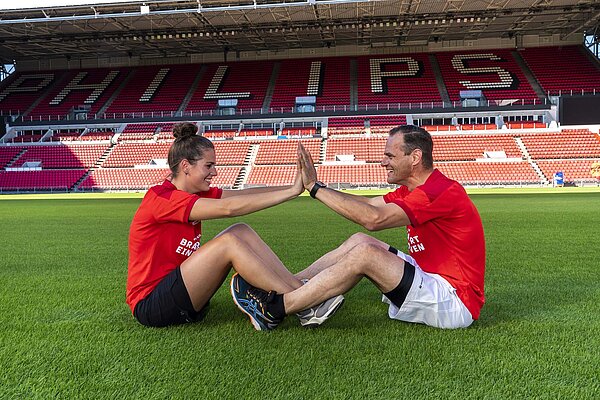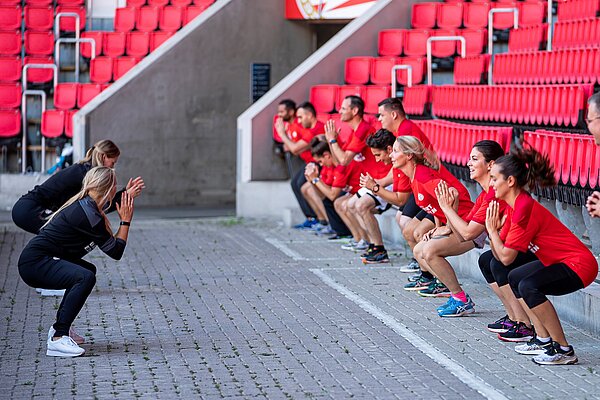
Spierversterkende activiteiten
Muscle strengthening activities are very useful and can be used for different purposes (which ones?). It can increase muscle strength and/or muscle size, also known as hypertrophy. In addition, muscle strengthening activities have health benefits (see examples?).
such as increased insulin sensitivity to prevent type 2 diabetes or reduce symptoms, increased rest metabolism which not only makes it easier to lose fat, but also reduces the risk of lifestyle related disorders.
Daarnaast hebben spierversterkende activiteiten voordelen voor de gezondheid. Zoals een verhoogde insuline gevoeligheid zodat diabetes type 2 wordt voorkomen of de symptomen verminderd, verhoging van de ruststofwisseling waardoor men niet alleen makkelijker vet kwijtraakt, maar ook minder risico heeft op leefstijl gerelateerde aandoeningen.
Regular exercise and exercise helps to get and keep supple and strong muscles. Your flexibility, muscle strength, balance and agility benefit from this. This is important to prevent falls. Exercise and sport increase muscle mass because the number of capillaries grows to better absorb oxygen from the blood. An increase in muscle mass improves posture. Strengthening the muscle corset prevents discomfort and problems with the back, shoulders and neck. Strong muscles relieve strain on your joints.
For the elderly, strength training can prevent sarcopenia (what is this?) or loss of muscle mass, because strength training appeals to almost more muscle fibres and the body will not break them down, which happens if they are not regularly activated. With one comment: muscles weigh more than fat.
Training target
Although strength training can be used for many purposes, it is important to focus on the following areas Training for a special training goal. The training goal ultimately determines how often, how much and how intensively you need to train. The training goals are often
muscle strength, muscle mass and muscle condition, but also take into account what you want to train and what your goal is, such as speed/explosivity and agility and coordination.
The data below are the standard guidelines that are used from classical training theory and have proven effective over the years.
Intensities
One of the most important elements of strength training is the intensity one is going to maintain in order to reach the goal. The intensity at which it is trained determines many other factors of strength training, such as the number of repetitions that can be achieved, the number of series, the speed of movement and the rest between series. The intensity of a strength exercise is often expressed as a percentage of the 1 Repetition Maximum (1RM). The 1RM is the weight that you can push or lift a maximum of once. This is a maximum strength exercise in which you are no longer able to do the same weight again with the same performance. The higher the intensity of the exercise, the greater the effects on muscle strength will be. Intensities above 80% are particularly effective for increasing muscle strength. To stimulate muscle mass it is recommended to start around 60% of 1RM and if possible to increase this to 80% 1RM. For muscle condition, the intensity is generally lower, around 30 and 60% of the 1RM is recommended

Repetitions
The number of repetitions depends on the intensity of the training. The higher the intensity of the training, the fewer repetitions one saves with resistance. When training for muscle strength and the intensity is high, the number of repetitions is usually low, 1-16 repetitions. For muscle mass, 6-12 repetitions are recommended. For muscle endurance, 12-25 repetitions are recommended.
Series
The number of series performed per exercise has a major influence on the final training result. When a muscle is stimulated more often, the training effect will be stronger, but this should not lead to overtraining. To develop both muscle strength and muscle mass, 3-6 series per exercise are recommended for both training goals. In order to stimulate muscle condition, it is of course necessary to carry out several series and recommends 4-8 series per exercise.
Rest between series
When performing several series per exercise, it is necessary to rest so that the next series can be performed again. In general, the shorter the rest, the more emphasis is placed on
developing muscle condition. The longer the rest, the more muscle strength can be trained because the muscles have more time to recover. This implicitly means that the training intensity can be less with short rest and the number of repetitions will be higher. When training to achieve muscle strength, the intensity is very high and the number of repetitions low, but for the best result a long rest is needed. The formation of muscle mass is mainly due to a lower intensity than training for strength, but it is best to keep the rest short so that muscle exhaustion can be achieved more quickly. Muscle exhaustion is an important factor in stimulating muscle mass. In summary, a rest of 2-4 minutes is optimal for developing muscle strength. Stimulating rest for muscle mass is 1 minute to 2 minutes between series and for muscle condition 15 seconds to 1 minute is recommended.
Training sequence
When designing a training schedule, it is important to think about the sequence of exercises. When strength training is applied properly, muscles become tired and exercises involving multiple muscle groups can be performed less well. For example, the triceps brachii, for example, become tired when an exercise is carried out first. If one then wishes to perform a chest press, it is possible that the pectoral muscles are trained less well because the triceps brachii that are also involved in this exercise are already tired and therefore cannot work optimally with the chest press exercise. It is therefore advisable to perform exercises involving several muscle groups before exercises involving only one muscle group.
| Muscle strength | Muscle mass | Muscle condition |
Intensity | 80 – 100% 1RM | 60-80% 1RM | 30-60% 1RM |
Repetitions | 1- 6 | 6-12 | 12-25 |
Series | 3-6 | 3-6 | 4-8 |
Rest | 2-4 min | 30 sec – 2 min | 15 sec – 1 min |
Do you also want to start strength training?
Then start the first 3 months with muscle condition training and try to work towards 4 series to a correct posture? Start with light weights and many repetitions so that your body can get used to the exercises and muscle injuries do not occur. It is also true that beginners hardly make any adjustments at muscle level in the first weeks of strength training and the increase in muscle strength is mainly due to improved muscle control.
Author: Nina de Rooij, PSV lifestyle coach
